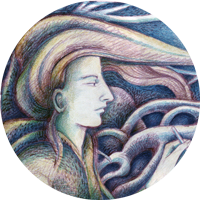I have a fascination for caves, as you may have seen from previous posts. Royston Cave in Hertfordshire has been on my radar for years. This year we were in the area and booked a tour to see the cave for ourselves.

Royston is a pretty, unassuming town, but it has a Roman road running through it as well as part of the Ichnield Way, an ancient track that runs from Wiltshire to Norfolk. Royston Cave is under the ground in the chalk where the two roads meet.
On the tour we descended steps and then followed a moderately steep passageway extending underground beneath the main road. Soon we found ourselves in a round chamber lit by wall lights. I could see engravings all around the lower part of the cave – faces, figures, crosses, birdlike fish, horses. Apparently the carvings are thought to be of the 14th century – medieval – and may be associated with the Knights Templar. In the 17th century a ten year old boy was instructed to descend into the man-made cave to see if there was any treasure in it. On further investigation the carvings were found.
On the walls, there are many religious depictions and symbols, but also some pagan imagery such as a shela-mi-gig. This shows that the carvings were made when pagan beliefs had not yet been totally obscured by Christianity.

Our guide started explaining what she knew about the carvings, starting with a St Christopher figure carrying someone on his shoulder (see the photo below on the left). There are other saints depicted, including Saint Catherine, shown holding a wheel as she was sacrificed on a burning wheel. Today people light Catherine wheels on Guy Fawks night to remember her.
To the left of St Christopher is a rectangle representing the tomb where Christ was buried, along with a hand and a bird-fish, possibly symbolising the Holy Spirit or risen Christ. There is a sword and a shield, a horse and the holy family.


There are many other drawings of knights, angels, rows of sinners and a figure holding a candle that may represent the light of the new religion that will lead believers out of darkness. Low down and to the right of the passage entrance is a crescent moon.
It was the figure of St Christopher that made the most impression on me. He is the patron saint of travellers and is said to have carried a child over a river who turned out to be Christ. I kept in mind the image of a figure carrying a rucksack, journeying on foot over the hills and drew and collaged a picture of this figure I have titled The Journeyman.

My figure is walking through a dreamlike, fluid, but fragmented landscape with the chalk figure of The Long Man of Wilmington in the distance. I like the idea of a traveller wandering the land without any particular destination, stopping here and there to find work. The ground in the picture looks unstable, symbolic of the unsettling times we’re living in.
I didn’t know what a journeyman was until I looked it up. Apparently the word originates from the Middle Ages and refers to a worker, such as a craftsman, who has acquired skills as an apprentice, but who is not yet a Master. He would work for an employee, often for a day (‘journée’ means ‘day’ in French) and was also known to travel around the country working here and there. There was a strong journeyman tradition in Europe.
When I googled ‘journeyman woodcut images’ I was surprised at how similar my drawing was to one of them.
I then decided to create an altered book titled The Journeyman.

I had in mind a present day journeyman walking over the Umbrian hills in Italy. I’ve never been to that region of Italy, but I imagined dry, rocky paths, leathery-leaved oaks, ibex and lynx. In my book you can see the spire of a church in the distance, a village in the valley. I’ve featured a cave and remember that there is the unusual, underground, spritual community of Damanhur in Northern Italy.
The altered book has seven illustrated pages on the left of the central spread and six on the right. It will be for sale in my Etsy shop and Reflections website shop soon.




















 I’ve done a new painting in a style that’s new for me. Kevin says it looks a bit ‘new agey’ and I can perhaps see what he means. It might be the subject matter or the colours, I’m not sure. I have been thinking about gathering birds, swallows in caves and starlings over the pier here in Brighton. They’re like twittering thoughts or memories in the loft of my mind; like a sixth sense telling me something is going to happen; there are dreams ‘waiting in the wings’.
I’ve done a new painting in a style that’s new for me. Kevin says it looks a bit ‘new agey’ and I can perhaps see what he means. It might be the subject matter or the colours, I’m not sure. I have been thinking about gathering birds, swallows in caves and starlings over the pier here in Brighton. They’re like twittering thoughts or memories in the loft of my mind; like a sixth sense telling me something is going to happen; there are dreams ‘waiting in the wings’.  I returned to this simple image when going through what I like to think of as my ‘goddess’ phase. I was initially inspired by an image Rainbow Bodhisattva by the artist
I returned to this simple image when going through what I like to think of as my ‘goddess’ phase. I was initially inspired by an image Rainbow Bodhisattva by the artist 

